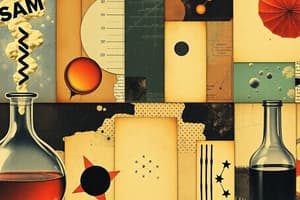Podcast
Questions and Answers
Which of the following statements about chemical changes is true?
Which of the following statements about chemical changes is true?
- Chemical changes always produce a new substance. (correct)
- Chemical changes only involve a change in color.
- Chemical changes have no energy change.
- Chemical changes can only be reversed by heating.
Physical changes always create new substances.
Physical changes always create new substances.
False (B)
What is the formula to calculate density?
What is the formula to calculate density?
Density = Mass / Volume
A mixture of components that are easily visible is known as a ______.
A mixture of components that are easily visible is known as a ______.
Match the types of bonds with their characteristics:
Match the types of bonds with their characteristics:
Flashcards
Chemical change
Chemical change
A change in matter where a new substance is formed with different properties. This change is often irreversible.
Physical change
Physical change
A change in matter where the form or appearance changes, but the substance itself remains the same. This change is usually reversible.
Covalent bond
Covalent bond
A bond between two nonmetals where electrons are shared between the atoms.
Ionic bond
Ionic bond
Signup and view all the flashcards
Compound
Compound
Signup and view all the flashcards
Study Notes
Chemical Changes
- Involve energy changes (heat or temperature)
- May produce a change in smell
- Can often be reversed
- Result in the formation of a new substance
- May show a change in color
Physical Changes
- Can be reversed
- Do not create new substances
- May involve a change in size
Solutions
- Mixtures of multiple components, often indistinguishable
- Example: Coke contains various substances not visually separable
Chemical Mixtures
- Mixtures of components easily visible
- Example: Chicken pizza shows separate components (chicken, cheese, bread)
Density
- Density (D) = Mass (M) / Volume (V)
Isotopes
- No specific detail provided
Covalent Bonds
- Form between two nonmetals
- Involve the sharing of electrons
Ionic Bonds
- Occur between a metal and a nonmetal
- Involve the transfer of electrons (metal loses, nonmetal gains)
Compounds
- Made from two or more different elements joined together
- Examples: H₂O, HCl
- Use prefixes (e.g., dioxide, trihydrogen) only when both elements are nonmetals; otherwise, use standard element names
Formulas
- Represent elements and their bonds
- Show electron sharing or transfer
- Use dots to visually represent electrons involved in bonding
Diatomic Molecules
- Seven elements naturally exist as diatomic molecules
- Memorization trick: "Have No Fear Of Ice Cold Beer" (H₂, N₂, F₂, O₂, I₂, Cl₂, Br₂)
Studying That Suits You
Use AI to generate personalized quizzes and flashcards to suit your learning preferences.




